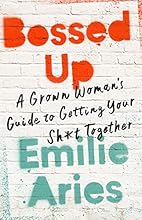Leadership Development & Career Advocacy Expert, Podcast Host, Author; Founder & CEO of Bossed Up
Emilie Aries Biography
Emilie Aries is an author, CEO & Founder, speaker, and podcast host. After rising quickly in the world of campaigns and elections as a grassroots organizer and digital strategist, she launched the award-winning leadership development and career services company, Bossed Up, in 2013.
Aries has worked with leaders at Fortune 500 companies to close the gender leadership gap and support diversity, equity, and inclusion initiatives at Facebook, American Express, Winstrust, Capital One, and Hilton Worldwide, and has been featured in media outlets including the Washington Post, CNN Money, Buzzfeed, NBC 9 News Denver, ABC 7 Washington, more.
Aries was ranked among such luminaries as Chelsea Clinton and Janet Mock in the LEVO 100, and received the Women’s Information Network’s Young Women of Achievement Entrepreneurship Award and the YWCA National Capital Area’s 2015 Rising Star Award.
Aries earned her B.A. in political science from Brown University and completed a Fellowship on Organizing: People, Power, & Change at the Harvard Kennedy School of Government. Aries is based in Denver, CO and combines her political past and personal experience with burnout to help others step into their power and be the boss of their careers and lives.
Contact a speaker booking agent to check availability on Emilie Aries and other top speakers and celebrities.
Emilie Aries Speaking Topics
-
Own Your Voice: Assertive Communication
Emilie decodes the differences between assertive and aggressive communication, and illustrates the benefits of asserting yourself (strategically) at work. Participants learn:
The difference between assertive and aggressive leadership;
Best practices for assertive communication through verbal, visual, and vocal mediums;
And how to speak up in a way that garners trust and respect.
-
Beat Burnout: The Science of Stress
Hard-working professionals aren't afraid of high-stress situations. But chronic stress without rest & renewal puts even the most committed team members at risk of complete & total burnout. In this interactive workshop, participants learn practical, research-based strategies to keep burnout at bay without compromising your work ethic, including:
The physiological stress response cycle;
The 4 root causes of burnout;
How to identify your burnout triggers;
And how to ditch the martyrdom mindset & aim for sustainable success instead.

-
How do I book Emilie Aries to speak at my event?
Our experienced booking agents have successfully helped clients around the world secure speakers like Emilie Aries for speaking engagements, personal appearances, product endorsements, or corporate entertainment since 2002. Click the Check Availability button above and complete the form on this page to check availability for Emilie Aries, or call our office at 1.800.698.2536 to discuss your upcoming event. One of our experienced agents will be happy to help you get speaking fee information and check availability for Emilie Aries or any other speaker of your choice. -
What are the speaker fees for Emilie Aries
Speaking fees for Emilie Aries, or any other speakers and celebrities, are determined based on a number of factors and may change without notice. The estimated fees to book Emilie Aries are $10,000 - $20,000 for live events and under $10,000 for virtual events. For the most current speaking fee to hire Emilie Aries, click the Check Availability button above and complete the form on this page, or call our office at 1.800.698.2536 to speak directly with an experienced booking agent. -
What topics does Emilie Aries speak about?
Emilie Aries is a keynote speaker and industry expert whose speaking topics include Author, Business, Business Growth, Business Leadership, Communication, DEI, Empowerment, Executive Leadership, Female Leadership, Gender Equality, Human Resources, Influential Women, Inspirational, Leadership, Marketing, Mindset, Negotiation, Non-Fiction Authors, Personal Growth, Podcast Host, Teamwork & Teambuilding, Women, Women in Business, Women's Empowerment, Women's History Month -
Where does Emilie Aries travel from?
Emilie Aries generally travels from Denver, CO, USA, but can be booked for private corporate events, personal appearances, keynote speeches, or other performances. For more details, please contact an AAE Booking agent. -
Who is Emilie Aries’s agent?
AAE Speakers Bureau has successfully booked keynote speakers like Emilie Aries for clients worldwide since 2002. As a full-service speaker booking agency, we have access to virtually any speaker or celebrity in the world. Our agents are happy and able to submit an offer to the speaker or celebrity of your choice, letting you benefit from our reputation and long-standing relationships in the industry. Please click the Check Availability button above and complete the form on this page including the details of your event, or call our office at 1.800.698.2536, and one of our agents will assist you to book Emilie Aries for your next private or corporate function. -
What is a full-service speaker booking agency?
AAE Speakers Bureau is a full-service speaker booking agency, meaning we can completely manage the speaker’s or celebrity’s engagement with your organization from the time of booking your speaker through the event’s completion. We provide all of the services you need to host Emilie Aries or any other speaker of your choice, including offer negotiation, contractual assistance, accounting and billing, and event speaker travel and logistics services. When you book a speaker with us, we manage the process of hosting a speaker for you as an extension of your team. Our goal is to give our clients peace of mind and a best-in-class service experience when booking a speaker with us. -
Why is AAE Speakers Bureau different from other booking agencies?
If you’re looking for the best, unbiased speaker recommendations, paired with a top-notch customer service experience, you’re in the right place. At AAE Speakers Bureau, we exclusively represent the interests of our clients - professional organizations, companies, universities, and associations. We intentionally do not represent the speakers we feature or book. That is so we can present our clients with the broadest and best performing set of speaker options in the market today, and we can make these recommendations without any obligation to promote a specific speaker over another. This is why when our agents suggest a speaker for your event, you can be assured that they are of the highest quality with a history of proven success with our other clients.
Emilie Aries is a keynote speaker and industry expert who speaks on a wide range of topics such as Own Your Voice: Assertive Communication, Beat Burnout: The Science of Stress and Active Allyship: Advancing Equity at Work. The estimated speaking fee range to book Emilie Aries for your event is $10,000 - $20,000. Emilie Aries generally travels from Denver, CO, USA and can be booked for (private) corporate events, personal appearances, keynote speeches, or other performances. Similar motivational celebrity speakers are Fran Hauser, Libby Gill, Kristie Kennedy, Amelia Rose Earhart and Donna Orender. Contact All American Speakers for ratings, reviews, videos and information on scheduling Emilie Aries for an upcoming live or virtual event.
This website is a resource for event professionals and strives to provide the most comprehensive catalog of thought leaders and industry experts to consider for speaking engagements. A listing or profile on this website does not imply an agency affiliation or endorsement by the talent.
All American Entertainment (AAE) exclusively represents the interests of talent buyers, and does not claim to be the agency or management for any speaker or artist on this site. AAE is a talent booking agency for paid events only. We do not handle requests for donation of time or media requests for interviews, and cannot provide celebrity contact information.
If you are the talent and wish to request a profile update or removal from our online directory, please submit a profile request form.

































